Examples of writing
The warrior of Capestrano: inscription
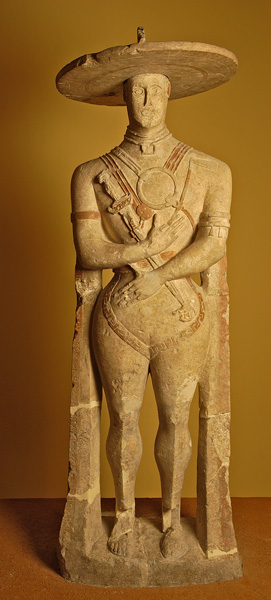
Source: Su gentile concessione della Direzione Regionale per i Beni Culturali e Paesaggistici dell'Abruzzo; Soprintendenza per i Beni Archeologici dell'Abruzzo - Chieti
The statue was found in 1934 near Capistrano in the modern province of L'Aquila and it is now in the Archaeological Museum of Chieti (inv. no. 4426). Carved on stone, it shows an inscription, running from right to left and from bottom to top, on the right-hand pillar that sustains the human figure. The sequence measures 98 cm and presents two unreadable points; the final part of the sequence is affected by an erasure of the whole area that precludes the reading of the text for about 9 cm. The text is in scriptio continua with letters ranging from 1.5 cm to 3.5 cm in height.
Inscribed text:
A. La Regina 1978:
ma kuprí koram opsút aninis rakinevíi pom[...]íi
A. Marinetti 1985:
ma kuprí koram opsút aninis rakinevíi pomp[--]í
A. La Regina 2010:
ma kuprí koram opsút Aninis raki Nevíi Pomp[uled]íi
Interpretation: This is a ‘speaking’ text and we can identify some elements: the object speaking (in the first person), with the personal pronoun at the front, ma kuprí koram; the expression of an action related to the verb 'to do', opsút; the subject, Aninis and the recipient of the action, rakinevíi/raki Nevíi Pomp[uled]íi.
The inscription bears the name of the artist commissioned to make the statue and of the recipient indisputably belonging to the higher ranks in the society; in the form raki La Regina recognizes a reference to kingship among local populations.
Bibliography: A. La Regina, Capestrano, in V. Cianfarani - L. Franchi dell'Orto - A. La Regina, Culture adriatiche antiche d'Abruzzo e di Molise, Roma 1978, pp. 310-312; A. Marinetti, Le iscrizioni sudpicene. I testi, Firenze 1985, pp. 239-243 (AQ. 2) e figg. 28-31; A. Marinetti, Le iscrizioni sudpicene, in AA.VV., Piceni popolo d'Europa, Roma 1999, p. 139; A. La Regina, Il guerriero di Capestrano e le iscrizioni paleosabelliche, in Pinna Vestinorum e il popolo dei Vestini, (a cura di) L. F. Dell'Orto, Roma 2010, pp. 239-245 e 261, nr. 16; M. H. Crawford (with W.M. Broadhead - J. P. T. Clackson - F. Santangelo - S. Thompson - M. Watmough; computing by E. Bissa - G. Bodard), Imagines Italicae. A corpus of Italic inscriptions, in Bulletin of the Institute of Classical Studies. Supplement 110, The Institute of Classical Studies University of London Vol. I-III, London 2011, pp. 226-227.
Inscription on a stone slab from Penna Sant'Andrea (Teramo) I
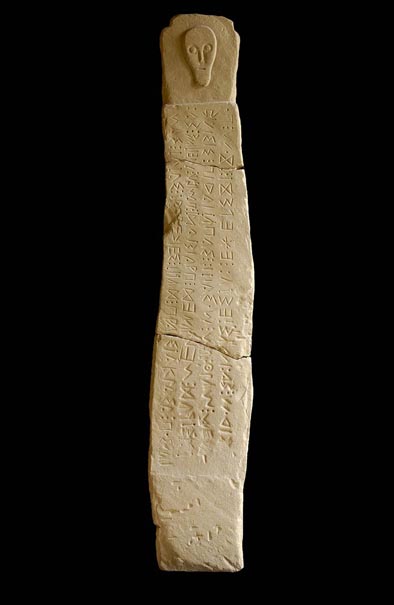
Source: Su gentile concessione della Direzione Regionale per i Beni Culturali e Paesaggistici dell'Abruzzo; Soprintendenza per i Beni Archeologici dell'Abruzzo - Chieti
The monument was discovered in 1973 and 1974 at Penna Sant'Andrea in the modern Province of Teramo and it is in the Archaeological Museum of Chieti (inv. no. 10016-10018). The slab consists of three corresponding and reassembled fragments (218 cm x 37.5 cm x 15.5 cm); the top of the upper fragment shows a human head. The inscribed sequence begins at the bottom right and runs on four lines alternately from right to left and from left to right with some graphemes overturned. The letters measure 5 cm; overlapping points made by a drill serve as punctuation between the words.
Inscribed text:
Marinetti 1985:
śidom ⁝ safinús ⁝ estuf ⁝ eśelsít ⁝ tíom ⁝ po/vaisis ⁝ pidaitúpas ⁝ fitiasom ⁝ múfqlúm ⁝ me[n/t]fistrúí ⁝ nemúnei ⁝ praistaít ⁝ panivú ⁝ meitims ⁝ saf/inas ⁝ tútas ⁝ trebegies ⁝ titúí ⁝ praistaklasa ⁝ posmúiš
Interpretation: the inscription is one of the longest in the South Picene corpus and presents a high degree of textual complexity and syntactic articulation. The core evidence is provided by the following lexical elements: safino- adjectival form for ‘to be Sabine’; túta- (for community) noun belonging to the institutional lexicon, already found in ancient Italy; praistakla(sa) indicating the monument. We can recognize the form praistaít with the value of 'to erect, to raise'; the deictic element esto ‘this one’ and pronouns posmúi ‘cui’ and tíom ‘you’ referred to the person to whom the monument and inscription are dedicated. We can assume that this is a laudatory and memorial text dedicated by a community to an important figure within the social group.
Bibliography: A. Marinetti, Le iscrizioni sudpicene. I testi, Firenze 1985, pp. 215-217 (TE. 5) e fig. 21; A. Marinetti, Le iscrizioni sudpicene, in AA.VV., Piceni popolo d'Europa, Roma 1999, p. 137; A. La Regina, Il guerriero di Capestrano e le iscrizioni paleosabelliche, in Pinna Vestinorum e il popolo dei Vestini, (a cura di) L. F. Dell'Orto, Roma 2010, pp. 258-260, nr. 13; M. H. Crawford (with W.M. Broadhead - J. P. T. Clackson - F. Santangelo - S. Thompson - M. Watmough; computing by E. Bissa - G. Bodard), Imagines Italicae. A corpus of Italic inscriptions, in Bulletin of the Institute of Classical Studies. Supplement 110, The Institute of Classical Studies University of London Vol. I-III, London 2011, pp. 196-197.
Inscription on a stone slab from Penna Sant'Andrea (Teramo) II
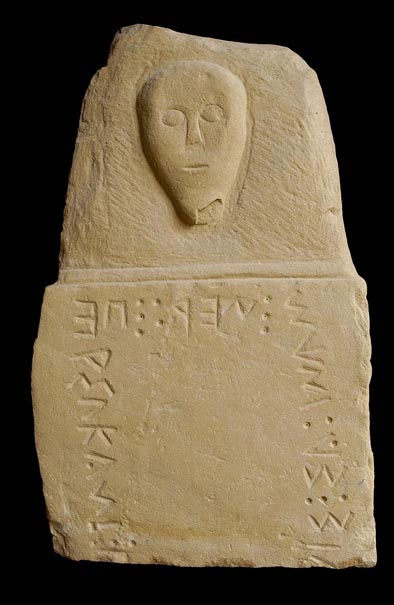
Source: Su gentile concessione della Direzione Regionale per i Beni Culturali e Paesaggistici dell'Abruzzo; Soprintendenza per i Beni Archeologici dell'Abruzzo - Chieti
The monument was found in 1973 near Penna Sant'Andrea in the modern Province of Teramo and is in the Archaeological Museum of Chieti (inv. no. 10014). Only the upper part of the slab is preserved and has a human head at the top (cm 74 x cm 45 x cm 12,5 - cm 16.5). The inscription runs alternately from left to right and from right to left on a single line and some graphemes are overturned. The letters measure 4.5 cm; overlapping points made by a drill serve as punctuation between the words.
Inscribed text:
A. Marinetti 1985:
]nis ⁝ safinúm / ⁝ nerf ⁝ pe/rsukant ⁝ p[
Interpretation: : the text is very fragmentary; however, some lexical evidence can be identified. The text mentions the nerf principes of the Sabines (genitive plural safinúm) performing the action expressed by the verb persukant, verb related to the value of 'to call, to celebrate'. We can assume that this is a laudatory text dedicated by the most prominent men of the community.
Bibliography : A. Marinetti, Le iscrizioni sudpicene. I testi, Firenze 1985, pp. 218-219 (TE. 6) e figg. 18-20; A. Marinetti, Le iscrizioni sudpicene, in AA.VV., Piceni popolo d'Europa, Roma 1999, p. 137; A. La Regina, Il guerriero di Capestrano e le iscrizioni paleosabelliche, in Pinna Vestinorum e il popolo dei Vestini, (a cura di) L. F. Dell'Orto, Roma 2010, pp. 260, nr. 14; M. H. Crawford (with W.M. Broadhead - J. P. T. Clackson - F. Santangelo - S. Thompson - M. Watmough; computing by E. Bissa - G. Bodard), Imagines Italicae. A corpus of Italic inscriptions, in Bulletin of the Institute of Classical Studies. Supplement 110, The Institute of Classical Studies University of London Vol. I-III, London 2011, pp. 198-199.
Inscription on a stone slab from Penna Sant'Andrea (Teramo) III
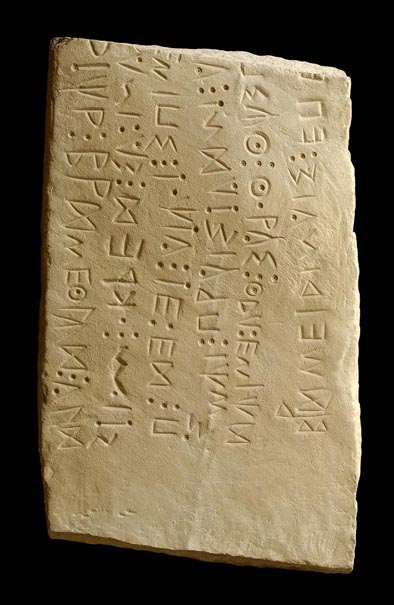
Source: Fonte
The monument was found in 1973 near Penna Sant'Andrea in the modern Province of Teramo and is in the Archaeological Museum of Chieti (inv. no. 10015). It is a fragment of a slab (cm 88 x cm 48 x cm 15 - cm 17). The inscription runs on six lines and its direction has been variously interpreted: while A. Marinetti assumes that the two lines of writing placed on the right side are not in succession, A. La Regina assumes that the sequence starts on the left side of the monument and runs from the top to bottom, boustrophedonically in three continuous segments. The letters measure 4.5 cm; overlapping points made by a drill serve as punctuation.
Inscribed text:
A. Marinetti 1985:
brímeidinais⁝ epe[ ]psúq⁝ qoras⁝
qdufenúí
]rtúr⁝ brímeqlúí⁝ alíntiom⁝ okreí⁝ safina[/
]nips⁝ toúta⁝ tefeí⁝ posmúi⁝ praistaínt⁝ a[
Interpretation: the text is fragmented and there may be as much missing as there is remaining. The following lexical elements can be identified: touta and okreí indicating the community and the arx probably determined by the adjectival safina[; the verb form, which can be integrated as o]psúq and interpreted as 'to do'; qoras indicates the monument and tefeí a personal pronoun in the dative case ('to you'). We can assume that this is a dedication to a highly cultural and social person, addressed as ‘you’.
Bibliografia di riferimento: A. Marinetti, Le iscrizioni sudpicene. I testi, Firenze 1985, pp. 220-223 (TE. 7) e figg. 18-20; A. Marinetti, Le iscrizioni sudpicene, in AA.VV., Piceni popolo d'Europa, Roma 1999, p. 138; A. La Regina, Il guerriero di Capestrano e le iscrizioni paleosabelliche, in Pinna Vestinorum e il popolo dei Vestini, (a cura di) L. F. Dell'Orto, Roma 2010, pp. 260-261, nr. 15; M. H. Crawford (with W.M. Broadhead - J. P. T. Clackson - F. Santangelo - S. Thompson - M. Watmough; computing by E. Bissa - G. Bodard), Imagines Italicae. A corpus of Italic inscriptions, in Bulletin of the Institute of Classical Studies. Supplement 110, The Institute of Classical Studies University of London Vol. I-III, London 2011, pp. 200-201.
Inscription on a bronze bracelet from the Pescara valley
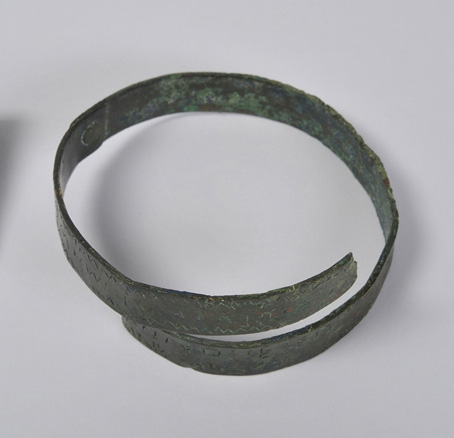
Source: Su gentile concessione della Direzione Regionale per i Beni Culturali e Paesaggistici dell'Abruzzo; Soprintendenza per i Beni Archeologici dell'Abruzzo - Chieti
The bronze bracelet was found by chance and in an unknown area, probably in the valley of the Pescara; it is in the Archaeological Museum of Chieti (inv. no. 27048). The lamina has a spiral form and is broken at both ends; the inscription is boustrophedon and the surface is also decorated with a ‘wolves teeth’ pattern. The object was restored in antiquity. The fracture at both ends has ruined a considerable portion of the inscribed sequence, which is lost. The graphemes measure from cm 0.2 to cm 0.4; overlapping points are used between the words as punctuation.
Inscribed text:
A. La Regina 2010:
[...]ômeô ·lufaniom ·ombriíen [ · ] akren ·postiknam ·putiô · knúskem · dúnoô · defia · uflfú [ · ] [...?...] ·titiúô · tefeô ·
Interpretation: we can identify some lexical elements including the form duno- likely connected to the verb 'to give'; the lexeme postiknúm identifies the votive object; the form fefe- seems to be a preterit form of the verb 'to do'; from a cultural point of view, the form ombriíen akren is interesting. We can assume that this is a dedication on a votive object, but the reference to the recipient and to the Umbrian ager are not clear.
Bibliography: A. Marinetti, Le iscrizioni sudpicene. I testi, Firenze 1985, p. 233 (CH. 2) ; A. Marinetti, Le iscrizioni sudpicene, in AA.VV., Piceni popolo d'Europa, Roma 1999, p. 138; A. La Regina, Il guerriero di Capestrano e le iscrizioni paleosabelliche, in Pinna Vestinorum e il popolo dei Vestini, (a cura di) L. F. Dell'Orto, Roma 2010, pp. 262-266 (nr. 19); M. H. Crawford (with W.M. Broadhead - J. P. T. Clackson - F. Santangelo - S. Thompson - M. Watmough; computing by E. Bissa - G. Bodard), Imagines Italicae. A corpus of Italic inscriptions, in Bulletin of the Institute of Classical Studies. Supplement 110, The Institute of Classical Studies University of London Vol. I-III, London 2011, pp. 251-252.
Inscription on a stone slab from Castel di Ieri (Aquila)

Source: Su gentile concessione della Direzione Regionale per i Beni Culturali e Paesaggistici dell'Abruzzo; Soprintendenza per i Beni Archeologici dell'Abruzzo - Chieti
The monument was found in 1949 at Castel di Ieri in the modern Province of L'Aquila and it is now in the Archaeological Museum of Chieti (inv. no. 5006). It is a fragment of a stele (53 cm x 25cm; 16 cm), missing pieces at the top and at the bottom, on which runs a bottom-to-top, three-line boustrophedon inscription. The surface of the monument appears in some areas damaged, which makes reading difficult. The graphemes are 3 cm high; overlapping points made by a drill serve as punctuation between the words.
Inscribed text:
A. Marinetti 1985:
]ah⁝ selah⁝ pimpíh ⁝[/
]m⁝ [-]oharme⁝ proiose⁝ r[/
]oiús⁝ boúediín⁝ haligatú⁝ [
Interpretation: this text is a good example of the difficulties involved in interpreting South Picene inscriptions: the monument is fragmented and it is not even possible to make inferences about the length of the text lost. There are not significant lexical elements; however, boúediín could be an ethnic reference recalling the pagus Boedinus later found in a Latin inscription.
Bibliography: A. Marinetti, Le iscrizioni sudpicene. I testi, Firenze 1985, pp. 244-246 (AQ. 3) e fig. 32; A. Marinetti, Le iscrizioni sudpicene, in AA.VV., Piceni popolo d'Europa, Roma 1999, p. 139; A. La Regina, Il guerriero di Capestrano e le iscrizioni paleosabelliche, in Pinna Vestinorum e il popolo dei Vestini, (a cura di) L. F. Dell'Orto, Roma 2010, p. 262 (nr. 18); M. H. Crawford (with W.M. Broadhead - J. P. T. Clackson - F. Santangelo - S. Thompson - M. Watmough; computing by E. Bissa - G. Bodard), Imagines Italicae. A corpus of Italic inscriptions, in Bulletin of the Institute of Classical Studies. Supplement 110, The Institute of Classical Studies University of London Vol. I-III, London 2011, pp. 242-243.